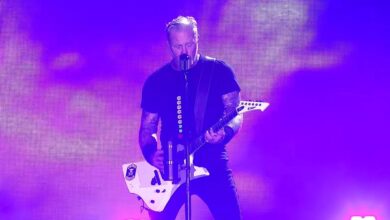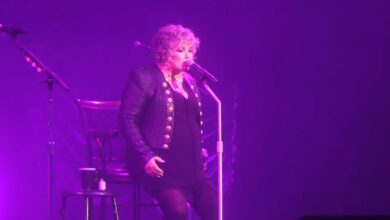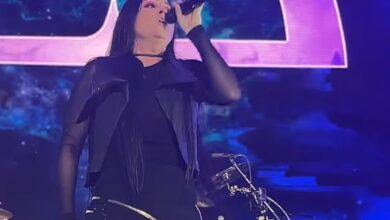Heart’s “Stairway to Heaven” Brings Led Zeppelin to Tears at the Kennedy Center
The evening carried the unmistakable hum of ceremony long before a note was played. Washington, D.C.’s Kennedy Center Opera House, bathed in winter formality, had convened to honor artists whose work reshaped American culture. Among the honorees sat Led Zeppelin’s surviving members—Robert Plant, Jimmy Page, and John Paul Jones—flanked in the balcony by President Barack Obama and First Lady Michelle Obama. When a guitar’s quiet figure eased into the room and a single voice began to rise, the atmosphere shifted from gala to pilgrimage. Heart’s Ann and Nancy Wilson were about to attempt the unthinkable: perform “Stairway to Heaven” in front of the men who created it, at an event designed to canonize them.
Context makes moments like this resonate. The Kennedy Center Honors are not a casual tribute show; they’re the capstone of a year’s artistic memory, taped in early December and broadcast to the country later that month. In 2012, the program celebrated Led Zeppelin alongside David Letterman, Dustin Hoffman, Buddy Guy, and Natalia Makarova—an eclectic roster that underscored how deep the band’s influence runs outside of rock’s borders. Even before Heart struck their first chord, the night had traced Zeppelin’s impact with performances from the Foo Fighters, Kid Rock, and Lenny Kravitz. But all roads pointed to the finale—six minutes of rock mythology that had to land.
What made the Wilson sisters the right artists for this tightrope? It wasn’t just long-standing admiration; it was a shared sense of theater and dynamics. As Nancy Wilson would later recall, the pressure of playing that opening guitar figure in winter air, with Page, Plant, and Jones watching, felt all too real—cold fingers, trembling knees, but a professional’s determination to make the first phrase bloom. That candid glimpse behind the curtain explained the performance’s poise: this “Stairway” would be built brick by brick, not blasted into the room. You could hear the nerves transform into intention as Ann Wilson’s vocal settled into the lyric.
The arrangement’s architecture was its secret weapon. Instead of unveiling the full band at once, the production unfolded in movements—intimate, then expansive, then overwhelming. A small ensemble gave way to strings and brass; a cluster of singers widened into full choir; textures thickened without swallowing the melody. The pacing honored the original’s famous slow-burn, but the staging translated it into spectacle: each new layer felt like a door opening to a larger space. The effect was cinematic, yet grounded in restraint, keeping the verses close and conversational before letting the roof lift.
And then there was the drum stool—the most symbolic seat in rock. When Jason Bonham stepped in, the moment snapped into focus. Wearing a bowler hat, he underscored a detail that would ripple through the hall: as the choirs joined wearing the same style hat, the visual nodded directly to his father, John Bonham, whose presence has long haunted any Zeppelin remembrance. It wasn’t sentimentality for its own sake; it was design, a visual grace note that turned the performance into a dialogue with memory. For an audience reading the stage like scripture, the message landed.
From that point, the piece stopped being a cover and became a ceremony. The Joyce Garrett Youth Choir’s entrance swelled the sound into a cathedral-size chorus, framing Ann’s lead with a halo of voices and giving Nancy’s guitar an almost liturgical pulse. The orchestration didn’t crowd the singers; it supported them like scaffolding, so that when the final crescendo arrived it felt earned, not engineered. Cameras caught Plant and his bandmates trading glances, the kind of small, wordless exchanges that say: “This is bigger than we expected.”
What audiences at home would later see—because the show aired nationwide weeks after the taping—was a finale that had both the intimacy of a living-room singalong and the thunder of an arena. The network broadcast packaged the performance as the capstone of the segment honoring Zeppelin, complete with shots of the balcony and the presidential box. The broadcast preserved crucial context: the night wasn’t a rock concert; it was a civic ritual dressed in formal wear, where a British band’s American legacy was being enshrined in a national institution. That juxtaposition made the tears on Plant’s face feel all the more human.
Ann Wilson’s lead carried a particular kind of gravity—clear, unfussy, emotionally direct. She didn’t imitate Plant; she inhabited the lyric’s arc, shifting from hush to ardor as the arrangement widened. Nancy’s acoustic figure, in turn, kept the music tethered to folk simplicity even as brass and choir piled on. You could feel the room lean forward through every modulation, like the audience was breathing with the band. It’s why the performance continues to circulate as more than nostalgia bait; it reads as a masterclass in escalation.
The production choices mattered just as much as the musicianship. Bowler hats on choir and drummer—one glance and the tribute’s intention was legible, acknowledging Bonham without a single spoken word. Brass and strings placed the song in a broader orchestral tradition, reminding viewers that “Stairway” has always sat comfortably between folk ballad and symphonic rock. The camera direction mirrored the music’s unfolding: close on Nancy’s hands early, wider frames as forces gathered, then balcony reaction shots at the summit. The result felt like a short film with immaculate timing.
If some classics are “uncoverable,” this rendition made the counterargument. Part of its success is the balance between reverence and reinterpretation. Heart didn’t try to out-Zeppelin Zeppelin; they leaned into their strengths—Ann’s stately power, Nancy’s storyteller touch—and let the arrangement do the translating. The measure of a great tribute isn’t mimicry; it’s whether it reveals something true about the original. Here, that truth was the song’s emotional architecture: the way longing becomes patience, patience becomes conviction, and conviction bursts into radiance.
As clips spilled onto the internet after the broadcast, the reaction was immediate and global. View counts soared, headlines marveled at Plant’s visible emotion, and the bowler-hat symbolism became a kind of shorthand for the performance’s quiet genius. Comment sections—rarely a refuge for agreement—filled with unusually unified praise. The video has remained a perennial resurfacer, the sort of clip that reappears in feeds every few months and still lands like news. That longevity speaks less to virality and more to craft.
Even the principals have reflected on the moment in ways that amplify its myth. Nancy Wilson has described the unique pressure of playing “Stairway” for its authors and a head of state, the cold backstage air, the resolve required to start alone and steady. Robert Plant, for his part, has talked about experiencing the performance as a kind of spectator of his own past—stripped of shopworn associations, able to hear the song again. When creators frame a tribute as revelatory, it usually means the interpreters found the right door into the material.
In retrospect, the performance also reads as a miniature history of rock production—how a song that begins as a parlor folk piece can grow, section by section, into a cathedral of sound without losing its narrative thread. The Kennedy Center’s staging took that lineage seriously: the orchestra wasn’t an add-on; it was an argument that the piece belongs in the same cultural conversation as torch songs and symphonies. That’s no small claim, but the reception—on site and at home—suggested people agreed.
There’s a practical lesson for anyone attempting sacred-cow repertoire. Start with story, not fireworks. Let arrangement serve arc, not ego. Give audiences the dignity of silence in the first minute so the last minute can thunder. Heart’s “Stairway” demonstrates that fidelity and imagination aren’t opposites; they’re collaborators. By the time the massed voices arrived at the final lines, the song sounded both exactly like itself and completely renewed. That paradox—familiar and reborn—is why the tribute endures.
If the Kennedy Center Honors are designed to bind pop culture to public memory, this performance set a high-water mark. It closed a segment that had already featured rock royalty paying respects and somehow still felt like the first time. When the last chord faded, there was a beat—just enough quiet for the audience to recognize that they had seen something rare, the kind of alignment between material, performers, place, and purpose that can’t be scheduled into being. You can only prepare, and hope, and then meet the moment. They did.
And so “Stairway to Heaven” added another chapter to its long tale—born in a British rehearsal room, reborn in an American concert hall, witnessed by presidents and peers, and carried forward by a drummer’s son and a choir in bowler hats. Decades after its debut, the song continues to test singers, reward patience, and turn rooms into cathedrals. That winter night in Washington proved it can also do something else: bridge generations with a single, carefully built crescendo and remind even its creators why they wrote it in the first place.





